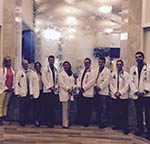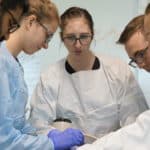Seeing patients for the first time can be a nerve-wracking experience for medical students. So, a new UCF College of Medicine training program geared toward giving third- and fourth-year students additional practice time on “dummy” patients is providing them with the skills to tackle challenging procedures.

The students practice on patient “manikins” – or jointed models of the human body – that can mimic symptoms, bleed, and even speak.
The program, titled “Procedures & Skills Practice Sessions” or “PSPS,” began in response to students requesting more clinical experiences before treating real patients during their rotations in area hospitals and clinics. It offers five procedures: venipuncture, IV placement, lumbar puncture, central line placement, and intubation.
In the lab, instructors can control the heart rates, oxygen levels, blood levels and breathing as well as simulate real-life medical emergencies on three different manikins – adult male and female patients as well as a child.
“I found the clinical skills session very helpful,” third-year medical student Tuleagh Innes-Gawn said. “It was very useful to get to learn practical skills on a manikin before performing them on a real patient.”
Dr. Christopher Gallagher, professor of anesthesiology, said the complexity of the patient cases changes based on the education level of the student, and he helps students work through each case to prepare them for the real thing.

“If you make a mistake … it’s not going to hurt them,” he said. “We can take a timeout and figure it out.”
Dr. Analia Castiglioni, assistant dean and medical director of clinical skills at the College of Medicine, said that it’s always important to give students as much exposure to medical procedures as possible while they’re in the safety of the simulation lab.
“It gives motivated students, or those interested in procedure-based specialties, a chance to review the equipment and steps involved in different advanced medical procedures,” she said.
The program is part of our 7,500-square-foot Clinical Skills and Simulation Center, which provides clinical settings for students to gain hands-on experience to learn and practice essential skills.

Students can train on a virtual simulation patient, who is programmed to represent particular conditions, or the manikins that help them distinguish particular heart, lung and bowel sounds – all important clues in a diagnosis. Rounding out the experience are more than 100 standardized patients – actors trained to provide a specific medical history so that students can reinforce their exam and communication skills.
The center serves an average of 300 medical students on a weekly basis throughout the academic year and also serves other medical institutions by training residents, nurses and physicians.
Thanks to advances in technology and medical education, the Clinical Skills and Simulation Center gives our future doctors more opportunities to practice their clinical skills in a safe environment before they ever reach the hospital wards or clinics. That’s good for learners and their future patients.



